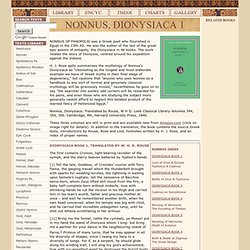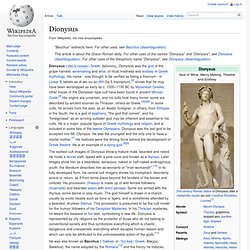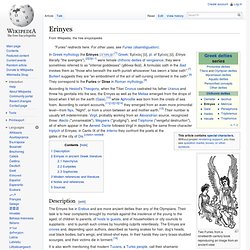

Women in Greek Myths. NONNUS, DIONYSIACA 1. NONNUS OF PANOPOLIS was a Greek poet who flourished in Egypt in the C5th AD.

He was the author of the last of the great epic poems of antiquity, the Dionysiaca in 48 books. The work relates the story of Dionysos, centred around his expedition against the Indians. H. J. Rose aptly summarises the mythology of Nonnus's Dionysiaca as "interesting as the longest and most elaborate example we have of Greek myths in their final stage of degeneracy," but cautions that "anyone who uses Nonnos as a handbook to any sort of normal and genuinely classical mythology will be grievously misled," nevertheless he goes on to say "the searcher into sundry odd corners will be rewarded for his pains, and even those who are studying the subject more generally cannot afford to neglect this belated product of the learned fancy of Hellenized Egypt. " These three volumes are still in print and are available new from Amazon.com (click on image right for details).
Daedalus. Family[edit] The Labyrinth[edit] Daedalus is first mentioned by Homer as the creator of a wide dancing-ground for Ariadne.[12] He also created the Labyrinth on Crete, in which the Minotaur (part man, part bull) was kept.

In the story of the labyrinth as told by the Hellenes, the Athenian hero Theseus is challenged to kill the Minotaur, finding his way with the help of Ariadne's thread. Daedalus' appearance in Homer is in an extended metaphor, "plainly not Homer's invention", Robin Lane Fox observes: "he is a point of comparison and so he belongs in stories which Homer's audience already recognized".[13] In Bronze Age Crete, an inscription da-da-re-jo-de has been read as referring to a place at Knossos,[14] and a place of worship.[15] In Homer's language, objects which are daidala are finely crafted.
This story thus encourages others to consider the long-term consequences of their own inventions with great care, lest those inventions do more harm than good. Greek mythology. Roman mythology. Roman mythology is the body of traditional stories pertaining to ancient Rome's legendary origins and religious system, as represented in the literature and visual arts of the Romans.

"Roman mythology" may also refer to the modern study of these representations, and to the subject matter as represented in the literature and art of other cultures in any period. The Romans usually treated their traditional narratives as historical, even when these have miraculous or supernatural elements. The stories are often concerned with politics and morality, and how an individual's personal integrity relates to his or her responsibility to the community or Roman state. Heroism is an important theme. When the stories illuminate Roman religious practices, they are more concerned with ritual, augury, and institutions than with theology or cosmogony.[1]
What Is the Relationship Between Roman and Greek Mythology? - mobile wiseGEEK. Dionysus. The earliest cult images of Dionysus show a mature male, bearded and robed.

He holds a fennel staff, tipped with a pine-cone and known as a thyrsus. Later images show him as a beardless, sensuous, naked or half-naked androgynous youth: the literature describes him as womanly or "man-womanish".[10] In its fully developed form, his central cult imagery shows his triumphant, disorderly arrival or return, as if from some place beyond the borders of the known and civilized. His procession (thiasus) is made up of wild female followers (maenads) and bearded satyrs with erect penises. Some are armed with the thyrsus, some dance or play music. The god himself is drawn in a chariot, usually by exotic beasts such as lions or tigers, and is sometimes attended by a bearded, drunken Silenus. Myth of Orpheus and Eurydice. Encyclopedia of Greek Mythology: Orpheus. Supremely gifted minstrel who attempted to rescue his dead wife from the Underworld.

Orpheus had been taught to play the lyre by Apollo, and such was his skill on the instrument, together with the sweetness of his singing voice, that he could charm wild animals and even cause trees to uproot themselves and follow in his steps. Jason and the Argonauts took him along when they quested after the Golden Fleece, and Orpheus saved them from shipwreck by drowning out the treacherously alluring voices of the Sirens with his own musical stylings.
Orpheus fell in love with a nymph named Eurydice and blissful was their life together until one day she was pursued by a son of Apollo, the minor deity Aristaeus. In her headlong eagerness to escape, she stepped on a poisonous snake, was bitten and died. Disconsolate, Orpheus found a cave which lead to Hades and followed Eurydice to the Underworld. This condition was so simple that it takes some explaining to account for Orpheus's failure to heed it. Orpheus and Eurydice Summary. The Short Story Ready?

Go. Orpheus and Eurydice get married, but later that night, Eurydice is bit by a snake and dies. So far, so terrible. Overcome with grief, Orpheus travels to the Underworld to bring her back to life. Unfortunately, Orpheus is overcome with passion just as they reach the exit. The Less Short Story We start off with a pretty typical boy-meets-girl story. THEOI GREEK MYTHOLOGY, Exploring Mythology & the Greek Gods in Classical Literature & Art.
Erinyes. Two Furies, from a nineteenth-century book reproducing an image from an ancient vase In Greek mythology the Erinyes (/ɪˈrɪniˌiz/;[1] Greek: Ἐρῑνύες [ῠ], pl. of Ἐρῑνύς [ῡ], Erinys; literally "the avengers"),[2][3][n 1] were female chthonic deities of vengeance; they were sometimes referred to as "infernal goddesses" (χθόνιαι θεαί).
